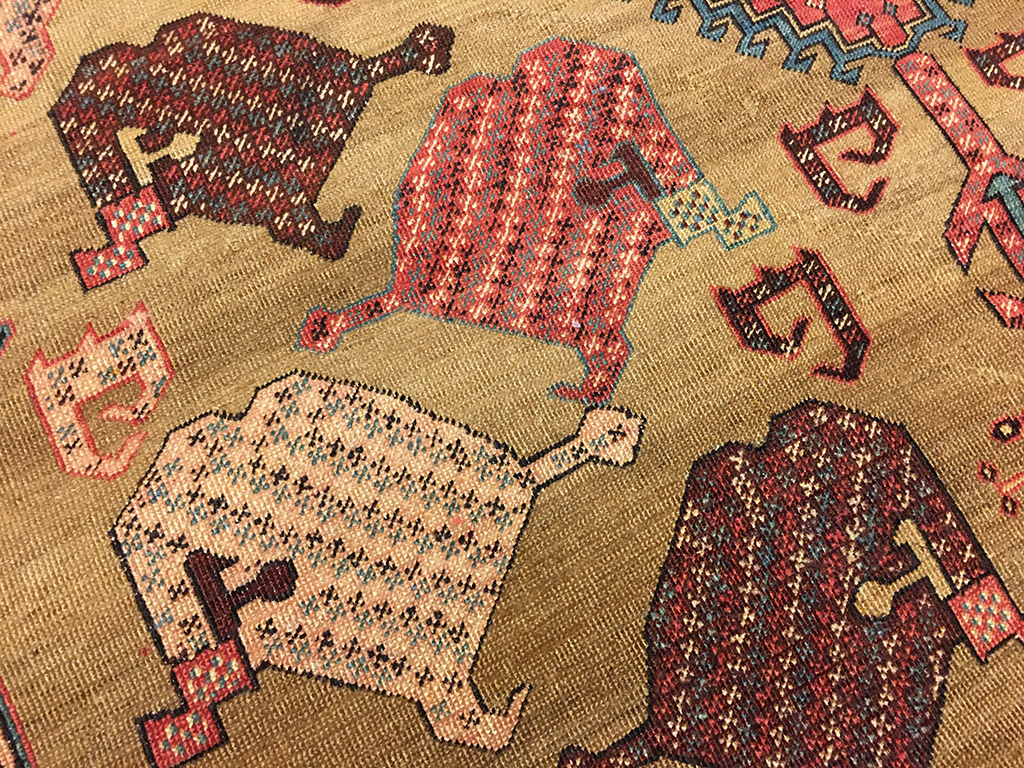Our Rug:
#22410
Bakhshaiesh
7’6” x 11’4”
Circa 1880
As Compared With:
#49 Northwest Persian Knotted Carpet
As seen in Seltene Orientteppiche Vol 5
by Eberhart Herrmann – p 104-105
325cm x 435cm (appx: 10’7” x 14’3”)
Circa mid 19th century
This essay aims to compare two carpets alike in style, to point out the differences and similarities for the purpose of highlighting the historical evolution of design in the Bakhshaiesh weaving region.
The first, and most obvious, difference between the two rugs is the size of the finished product. The example published in Seltene Orientteppiche is a much larger carpet, probably woven for export to Europe or America, while our rug has a size more indicative of use in a Persian home.
Moving on we note that both pieces employ what is known as an animal pelt design element – which refers to the shape of the shield within the field being reminiscent of animal fur carpets. While both carpets utilize a soft camel colored wool within the shields, the blue ground color found outside of this shape is softer on our rug, and our medallion red compared to navy in the published piece. In both carpets the ribbon which separates the shield from the blue ground is decorated with gridded five-piece squares, which is recurrently used throughout both as a textural fill for many of the design elements. Our rug’s ribbon differs, however, by the use of indentations which seem to grasp the shield within.



In the publication of the example piece, Herrmann discusses another carpet woven circa 1800 (published by Schurmann in 1976) which utilizes this color scheme as well as the depiction of “archaic dragons in the field and corners, which are explained by the proximity of the Caucasus”. He concludes based on this model that our example piece utilizes “extremely stylized and simplified animal shapes for which early Turkish animal carpets should also be used for interpretation” – pointing out that the sickle-shaped C motifs found in the stylized forms of the carpet are also found in earlier characterizations of animals in these Turkish rugs.



While our rug does not utilize this “C” shape within the stylized forms, it further distorts the execution of this design element with an angular hook motif connected to block shapes. It is unclear what exactly these blocks are to represent. Perhaps another difference to point out is the overall fluidity vs rigidity between the stylized forms of the two carpets. Those found in the published example are more both more angular in their shape, as well as more linear in their placement than those found in our rug.
Both rugs also provide representations of smaller animals dispersed through the field, though the published example showcases very small representations of birds, as well as two human figures, not present in our carpet. Herrmann theorizes that “the depiction of two figures dressed differently can indicate that the carpet was made for a special occasion, such as a wedding.”
Other elements to note variation with are the use of flowers in the field of the example piece, while our rug utilizes crosses. The example carpet also displays repetition of the same flowers in a linear row along the sides of the shield, while our rug makes use of a wider area to house a more intricate floral and leaf vine pattern. The most notable variation between the two designs is probably the border. Our rug’s border is less busy than the example – displaying a large scale flower and leaf pattern which is somewhat rigid in its application.


One final thing to note is that the published example was likely woven to be viewed from either end of the carpet – as the design elements are woven in reverse of each other from the center of the rug. In our rug on the other hand, the elements are one directional, which is noted even by the horns displayed at each end of the arms which project vertically from the central medallion.




Is one rug’s design better than another? I believe it is all in the eye of the beholder; style is a preference, personal to the viewer. One thing is clear however, and that is the fact that both of these carpets were woven in, and influenced by cultural context of, a specific weaving area.


